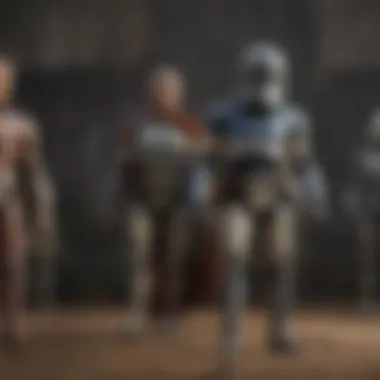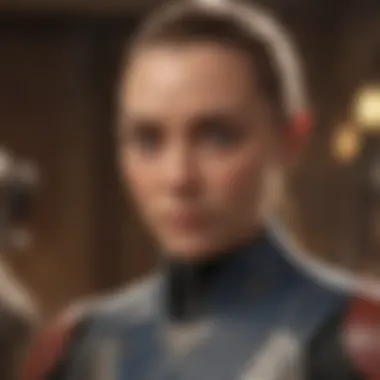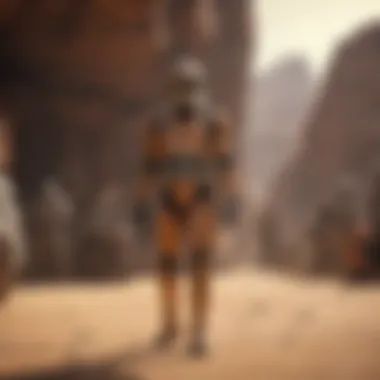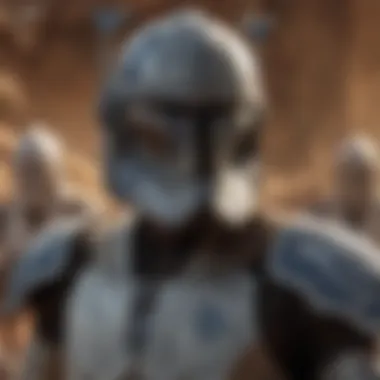Mastering the Viewing Order of Star Wars: The Clone Wars


Intro
Star Wars: The Clone Wars is more than just a series; it is a rich tapestry that deepens the lore of the Jedi and Sith, complicating relationships and highlighting the struggles of war. For avid fans or newcomers looking to understand the captivating world of Clone Wars, the order in which episodes are viewed can dramatically alter the experience. The narrative weaves multiple arcs across its seven seasons, blending action-packed plots with profound character evolution. Making sense of this complexity requires a thoughtful approach, as there are numerous ways to engage with the show.
To fully appreciate the series, one must consider not only the chronological order of episodes but also how certain storylines interrelate. This guide not only details the recommended viewing order but also provides insights into narrative structure, character development, and the thematic elements that shine throughout the saga. A comprehensive examination of this nature aims to facilitate both seasoned aficionados and those encountering Clone Wars for the first time, ensuring a satisfying viewing experience.
Understanding Star Wars: The Clone Wars
In any meaningful dive into the galaxy far, far away, one must grasp the essence of Star Wars: The Clone Wars. This animated series doesn't simply add depth to the saga; it stitches together narratives that resonate throughout the entire franchise. Whether you’re a newcomer to the fold or a seasoned Jedi, serving knowledge about this significant entry facilitates a richer understanding of characters, themes, and plot mechanisms that are woven into the Star Wars mythos.
Ah, the terrain of animated storytelling! This show has a unique ability to breathe life into characters that fans may recognize, like Anakin Skywalker and Ahsoka Tano, while simultaneously introducing new faces that become pivotal to the series’ overarching narrative. The emotional undercurrents and character arcs transcend mere entertainment, offering meditations on choices and consequences, thus elevating the entire viewing experience for the audience.
Overview of the Franchise
Star Wars began as a singular saga but has grown into a sprawling narrative universe, encompassing movies, series, novels, and comics. The Clone Wars era holds a distinct place in this hierarchy, set between Episode II: Attack of the Clones and Episode III: Revenge of the Sith. Followers of the franchise quickly learned that this animated show is far more than just a children’s program; it’s a robust exploration of the dark underbelly of galactic conflict, showcasing the choices that imperfect heroes make in the face of adversity.
In numerous ways, the franchise operates like a domino chain: start one story, and it influences the next, ultimately leading to far-reaching implications. This interconnectedness prompts viewers to reconsider familiar narratives, forging emotional bonds with the characters and their fateful decisions.
The Significance of The Clone Wars
Why does The Clone Wars deserve a place at the forefront of discussions about Star Wars? For starters, this series delves into complex themes often glossed over in major motion pictures. The exposition of morality, duty, and friendship seeps into various story arcs, significantly enriching the path to the tragic fall of Anakin Skywalker. The careful crafting of each episode reveals a deeper emotional spectrum, often contrasting the bright lightsaber battles with darker moments of despair and betrayal.
Furthermore, The Clone Wars presents war in a multifaceted manner, showing its disarray not just on a battlefield but also within the hearts and minds of those involved. Characters like Ahsoka Tano resonate deeply as they navigate questions of loyalty and identity, particularly when faced with the harsh truths of war and its consequences.
In essence, neglecting The Clone Wars is akin to missing a key chapter in a compelling novel; the significance ingrained in these stories reverberates throughout the broader Star Wars universe.
"The Clone Wars may be animated, but the emotional weight it carries is anything but light."
In summary, navigating the details of Star Wars: The Clone Wars allows one to unpack narratives that redefine traditional heroism and friendship, making it a crucial element in understanding the epic saga that connects generations of fans.
The Structure of The Clone Wars
Understanding the structure of Star Wars: The Clone Wars is crucial for fans and newcomers alike. The show’s framework not only lays the ground for its engaging narrative but also helps in navigating its complex chronology. Each season builds upon the last, incorporating various themes and character arcs that shape the overall story. This section dives deep into the layout of episodes and their significance, offering a lens into how the series developed over time.
Seasons and Episodes: A Breakdown
Star Wars: The Clone Wars consists of seven seasons, each comprised of a varied number of episodes that contribute distinctively to the overarching plot. The first season introduces audiences to the turmoil of the Clone Wars, presenting key players and settings that familiar fans will recognize from broader Star Wars lore. While some episodes serve as standalone stories, others set the stage for deeper arcs that unfold in subsequent seasons.
- Season One: Begins with the fierce battle of Christophis, where Anakin Skywalker, Obi-Wan Kenobi, and Ahsoka Tano first unite against the Separatists. The tone is set for the long-standing conflict showing the internal struggles and growth of its characters.
- Season Two: Takes a darker turn, exploring deeper moral dilemmas. Fans witness a richer depiction of character relationships and how their choices affect their destinies. Anakin's complexities as he juggles the responsibilities of war and his secret relationship with Padmé Amidala become increasingly evident.
- Season Three: Is noted for its groundbreaking arcs, like the "Mortis" trilogy, presenting profound philosophical themes. Here, the story ventures into the mystical aspects of the Force, showcasing the struggle between light and dark.
- Seasons Four to Seven: Each progressively pushes boundaries, culminating in epic battles, intense character conflicts, and, ultimately, revealing the early seeds of betrayal within the Galactic Republic. Ahsoka's departure from the Jedi Order in Season Five serves as a pivotal moment, highlighting themes of loyalty, disillusionment, and the search for identity.
This episodic layout ensures that viewers can grasp complex narratives while savoring distinct moments that characterize the Clone Wars saga, making it essential for understanding the broader lore of the Star Wars universe.
Narrative Arcs and Their Impact
Narrative arcs within The Clone Wars are not mere storylines; they are the beating heart of the series. Each arc weaves together episodes to showcase specific themes or character developments that resonate deeply with the audience. This structural approach allows creators to delve into characters' backgrounds, initiatives, and consequences in a compelling manner.


- Character-Driven Arcs: Take Ahsoka Tano for instance. Her evolution from a young Padawan, playful and somewhat naive, to a strong-willed individual who ultimately rebels against the Jedi Council challenges traditional narratives of heroism. Her journey strongly contrasts with Anakin's, adding layers of complexity.
- Thematic Exploration: The arcs also explore broader themes such as the nature of war itself, loyalty, and the consequences of choices made in tumultuous times. This layer of depth encourages viewers to reflect on moral ambiguity rather than painting their experiences in black and white.
- Integration with Star Wars Lore: The narrative cleverly integrates with the established Star Wars mythos, enriching it by showcasing lesser-known characters like Captain Rex, whose development reflects the struggles of clone troopers with autonomy amid the chaos of battle.
In summary, the structure of The Clone Wars isn’t just a series of interconnected plots. It’s a meticulous tapestry of character studies, thematic explorations, and philosophical inquiries, compelling the audience to engage on multiple levels. This immersive design is what sets it apart as a significant installment within the Star Wars franchise.
"The series takes you on a rollercoaster, from laughter to tears, and it’s all linked tightly through its brilliant structure."
The nuances offered in Star Wars: The Clone Wars demonstrate that its viewing order is not merely a chronological favor but an experience shaped distinctly by its structural choices.
Chronological Viewing versus Release Order
When diving into the intricacies of Star Wars: The Clone Wars, one pivotal consideration that fans often grapple with is the order in which to consume the series. This isn’t merely a trivial choice; it's essential in shaping one's understanding of the story, character arcs, and thematic depth. Choosing between chronological viewing and release order becomes a strategic decision, particularly because the series has a multi-layered narrative that unfolds over several seasons. Each method offers unique insights and connections that can profoundly affect viewer experience.
Understanding Release Order
Watching The Clone Wars in its release order provides a perspective that aligns with how audiences originally experienced the series. It captures the zeitgeist of its release and allows viewers to revel in the suspense and cliffhangers intended by its creators.
- Authenticity: This order reveals how the series was designed to progressively introduce themes and character developments. New plot arcs emerge as they were meant to—much like encountering a plot twist in real-time.
- Cultural Context: The cultural and media environment of its airing period from 2008 to 2020 plays into how we perceive certain events and decisions made by characters.
Adopting the release order, fans engage with characters as the creators intended, experiencing their growth and challenges parallel to the unfolding adventure of the Star Wars saga.
Exploring Chronological Order
Alternatively, opting for a chronological viewing allows one to follow the timeline of events as they unfold in the Star Wars universe. This method sheds light on character motivations and relationships that might not be as apparent through release order.
- Timeline Clarity: By consuming episodes in chronological order, the connections between individual arcs become sharper, revealing how previous events directly influence later developments. It offers a continuous narrative flow, eliminating any possible confusion with episodic leaps.
- Deeper Character Insights: Characters are often seen at various stages of growth, making it easier to grasp their transformations and decisions made in specific contexts. Anakin's struggle with the force's duality is significantly highlighted this way, showcasing his descent long before his external conflicts come to a head.
Benefits of Each Viewing Method
Both viewing methods present their own merits, and the choice largely depends on what viewers aim to glean from their experience. Here are some insights into what each method offers:
- Release Order:
- Chronological Order:
- Preserves the surprise and emotional weight intended for original audiences, which may provide a nostalgic experience for long-time fans.
- Ensures that certain episodes are recognized for their impact as they aired, hence amplifying their narrative significance.
- Provides clearer contextual understanding of events, enforcing a coherent storyline.
- Helps in grasping character motivations and relationships more effectively.
Ultimately, whether one chooses chronological or release order, both methods enhance appreciation for the meticulous craftsmanship behind Star Wars: The Clone Wars. Each framework paints a different picture of the narrative tapestry, issuing insights that resonate long after the credits roll.
Key Character Developments
The character arcs in Star Wars: The Clone Wars form the backbone of the series, driving its emotional weight and thematic significance. Each character not only evolves throughout the show but also represents a facet of the broader narrative’s exploration into morality, loyalty, and the implications of war.
Anakin Skywalker’s Journey
Anakin’s transformation is perhaps the most compelling element of the series. Initially portrayed as a confident Jedi Knight, his journey is laced with internal conflict and moments of doubt. As the war progresses, viewers watch Anakin wrestle with his emotions—his fear of loss, his attachment to his loved ones, particularly Padmé Amidala, and the burden of his responsibilities.
A pivotal moment occurs during Season 5, Episode 1, titled "Revival," where Anakin faces off against Darth Maul. This episode showcases not just his combat prowess but also highlights the tension between his role as a protector and his propensity towards aggression. It's in these moments of tension that his descent into darkness becomes palpable. While the Jedi Council often questions Anakin's methods, the audience sees that it’s his emotional attachments and increasingly desperate actions that lead him down the ominous path to becoming Darth Vader.


In this way, The Clone Wars serves as a profound commentary on how good intentions can unravel into catastrophic decisions. The complexity of Anakin’s character invites viewers to engage with the narrative on multiple levels, questioning their own definitions of heroism and betrayal in tumultuous circumstances.
Ahsoka Tano's Transformation
Ahsoka Tano’s evolution throughout the series is equally fascinating. Introduced as Anakin's Padawan, her character grows from a headstrong and impulsive young Jedi into a strategic and independent leader. Her journey is filled with critical lessons about trust, identity, and conflict with authority.
One of the most significant turning points comes in Season 5, Episode 20, in "The Wrong Jedi." After being falsely accused of a crime, Ahsoka is faced with a choice between loyalty to the Jedi Order and her own sense of justice. This moment of betrayal leads her to question everything she believed in. Her eventual departure from the Jedi Order profoundly impacts the overarching narrative and underscores the theme that not all paths lead to the light.
Ahsoka’s transformation also touches on broader themes of empowerment and resilience, depicting a character who chooses her own destiny despite the expectations and standards of those around her. Her evolution resonates with many viewers, presenting a strong female character who cultivates independence in a galaxy of chaos.
The Role of Supporting Characters
Further enriching The Clone Wars are the supporting characters, each contributing unique perspectives and backstories that complement the central arcs of Anakin and Ahsoka. Characters like Obi-Wan Kenobi provide a moral compass, constantly emphasizing duty and adherence to the Jedi Code. In contrast, characters such as Captain Rex exhibit loyalty and camaraderie, standing as a testament to the bonds forged amidst war.
Additionally, the introduction of characters like Asajj Ventress and Maul complicates the narrative fabric. Ventress, for example, transitions from antagonist to anti-hero over the series. Her struggles with her own identity and redemption arc illustrate that the line between good and evil is often blurred in the cosmic tapestry of the galaxy.
Through their interactions, these supporting characters help to mold the protagonists and provide depth to their emotional journeys. Ultimately, The Clone Wars reveals that every character, regardless of their role, plays a part in shaping the fate of the galaxy.
"In the end, it is the relationships and growth of these characters that truly define The Clone Wars experience."
In summary, the intricate character developments found in Star Wars: The Clone Wars not only enhance the plotlines but also invite viewers to reflect on larger questions of morality and humanity within the chaos of war.
Thematic Elements and Motifs
Unraveling the thematic elements and motifs within Star Wars: The Clone Wars is crucial for understanding its complex narratives. The show intertwines various themes that speak to both individual and collective experiences during the chaos of war. Through these elements, it not only entertains but also prompts deeper reflection on morality, relationships, and the overarching consequences of conflict.
Exploration of Heroism and Morality
At the heart of The Clone Wars lies a profound exploration of heroism and morality. Characters often grapple with ethical dilemmas that challenge their notions of right and wrong. Take Anakin Skywalker for instance; his journey is marred by choices that blur moral lines. As he transitions from a promising Jedi Knight to a conflicted figure, the audience witnesses firsthand the weight of his decisions.
Heroism isn’t just limited to grand gestures or epic battles; in this series, it often manifests in subtle acts of bravery. Ahsoka Tano embodies this as she continually stands up against injustices, even as she evolves beyond the Jedi principles. This layer of complexity not only humanizes the characters but also allows viewers to question their definitions of heroism. What does it mean to be a hero? The show invites the audience to draw parallels between its narratives and contemporary issues, proving relevant across generations.
War and Its Consequences
The consequences of war shape not only the physical landscape but also the minds and hearts of the characters. The Clone Wars deftly shows how conflict alters lives, often with irreversible outcomes. It isn’t merely a backdrop; it’s a character in itself that drives the plot forward. The visual storytelling—through battle scenes filled with chaos, loss, and destruction—acts as a stark reminder of war’s brutality.
One poignant example can be found in episodes like The Deserters, where the toll of war is laid bare. This narrative illustrates how soldiers are affected long after the battles cease. By depicting the suffering faced by both sides, the show fosters empathy, challenging audiences to reflect on the broad impact of military conflicts. The storyline prompts viewers to ponder questions like “What happens to humanity when war becomes a norm?”, thereby deepening the engagement with the subject matter.
Friendship and Betrayal
The intertwining themes of friendship and betrayal add yet another layer to The Clone Wars. The relationships formed between characters often undergo tests that reveal the fragility of trust in times of conflict. Ahsoka’s departure from the Jedi Order is a striking example. It encapsulates feelings of betrayal from those she once considered allies. As she navigates through these fractured bonds, viewers are compelled to reflect on their own experiences with trust and loyalty.
Moreover, the friendships throughout the series showcase the power of unity amid turmoil. Clones, such as Captain Rex, display fierce loyalty to their comrades, contrasting sharply with the betrayals that happen at higher levels of command. These themes resonate with audiences, as they mirror real-life complexities in relationships when faced with external pressures.
“In war, not everyone is who they seem, and sometimes your greatest friend might just be your greatest enemy.”
Critical Reception and Legacy


Understanding the critical reception and legacy of Star Wars: The Clone Wars is essential in framing its significance within the broader Star Wars narrative and pop culture at large. This section will unravel the varied responses from critics and viewers alike while examining how this animated series influenced future storytelling in the Star Wars universe and beyond.
Review Analysis and Audience Feedback
The reviews of The Clone Wars have been as varied as the characters it showcases. Initially, when the series debuted in 2008, it faced skepticism from hardcore Star Wars fans. However, critics quickly came around, often praising the depth of storytelling and character development. Take, for instance, the reviews from Rotten Tomatoes. The show's ability to delve into complex themes such as morality and loyalty gained traction, which was especially noted in seasons four through six, where the narrative broke new ground for children’s animation.
"The Clone Wars transformed how narratives could unfold in animation, delivering mature themes that resonate deeply, far beyond simple good versus evil."
- A popular critical sentiment.
Audience feedback revealed an evolving perception of the series. Fans appreciated the continuous arc of Anakin Skywalker, among others, as it provided richer context for his eventual fall to the Dark Side. This return to the Star Wars roots helped cement The Clone Wars as more than just a side story. Furthermore, the introduction of Ahsoka Tano turned her into a beloved character, with the fandom rallying around her journey from apprentice to leader.
Impact on the Star Wars Universe
The cultural ripples of The Clone Wars in the Star Wars universe are profound. It did not just fill in the gaps between Attack of the Clones and Revenge of the Sith; it explored the nuances of war, the heroism in turmoil, and the shadows that creeped into the hearts of many who fought in it. Characters such as Admiral Thrawn and the concept of the Jedi being flawed heroes became significant points of discussion, impacting future media directly.
This influence can be seen in the development of new Star Wars projects. The show provided a backbone of lore that filmmakers and series developers have drawn from for projects like Star Wars Rebels, and even parts of The Mandalorian. The level of detail and investment in character arcs set a standard for future narratives within the franchise.
- Key impacts include:
- Development of prominent characters that transcend their origins.
- Introduction of complex themes that were carried forward into films and new series.
- Setting a new narrative standard for animations and broader media storytelling.
Influence on Future Media
The Clone Wars has also forged a path for subsequent animated and live-action series. Its success demonstrated that animated narratives could truly resonate with audiences across age groups. Other franchises began to take cues from its storytelling model, adopting similar approaches in character development, pacing, and interwoven plots.
With characters like Ahsoka Tano and Bo-Katan, the series opened a door for female leads to emerge in prominent roles. Their complexities and depth added layers to the franchise that were previously unexplored. Shows like Star Wars: Rebels and even The Bad Batch have built upon this legacy, finding themselves able to explore themes that extend beyond traditional confines.
Epilogue: Synthesizing the Clone Wars Experience
As we wrap up our exploration of Star Wars: The Clone Wars, it's vital to understand how all the threads come together. Navigating the viewing order isn’t just about the sequence of episodes; it's about how these episodes serve the broader narrative. This article peels back the layers of the series, revealing the intricacies of its timeline and the relationships between characters.
The significance of this discussion lies in its potential to enhance viewers’ appreciation of the series. For fans both new and old, understanding the choices in chronological versus release order can vastly influence their experience. It’s like piecing together a jigsaw puzzle where each episode adds a new layer of depth. When viewers watch The Clone Wars in chronological order, they can witness a continuous character evolution, drawing connections that might be missed when following the release order. However, the latter approach allows for the suspense and excitement that comes with discovering twists in the moment.
Final Thoughts on Viewing Order
Choosing the right viewing order brings us to a significant point of consideration. Whether you dive into the release order or opt for chronological viewing, each approach has its unique flavor, much like different recipes for a favorite dish. The release order presents a story crafted for suspense. Early viewers experienced the surprises as intended, which adds nostalgia for long-time fans. Conversely, chronological viewing creates a seamless experience, facilitating a understanding of character developments that unfold over time.
- Release Order Benefits:
- Chronological Order Benefits:
- Captures the original excitement and pacing.
- Presents character arcs as the creators intended for maximum emotional impact.
- Fosters a clear understanding of story arcs.
- Showcases character connections and transformations more explicitly.
Ultimately, the choice is personal. Each fan will uncover their own bonding experience with the series, molded by which order they choose as they journey through the tumultuous galaxy far, far away.
The Enduring Appeal of The Clone Wars
Star Wars: The Clone Wars remains a beloved chapter in the Star Wars saga. Its appeal stems from the rich world-building and character exploration that captures the ire of fans. Unlike many animated series, it juxtaposes lighthearted moments with somber themes, adding weight to character choices and moral questions.
This series brought Star Wars narratives into a deeper exploration of war’s consequences, friendship, and betrayal. Ahsoka Tano, for example, evolves dramatically, reflecting a complex journey that resonates with viewers. The meticulous creation of characters complements the overarching themes, enhancing the timelessness of the series.
“The Clone Wars enriches the universe, adding depth that feels essential to the entire saga.”



